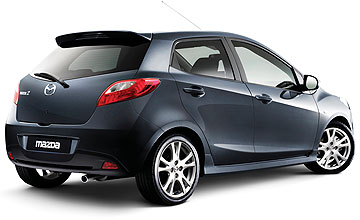BY BYRON MATHIOUDAKIS | 6th Sep 2007

Curse? Well, replacing the much-loved Bubble with the mini-MPV-style (Mazda’s own words) Metro was – to its predominantly young female/gay audience – like switching from Madonna to Barry Manilow.
And while the outgoing DY ‘2’ that supplanted the Metro back in late 2002 was a whole heap better, it seemed that the practical Mazda had practically cornered the pensioner market.
But... holy Copacabana! Look at what’s replaced it now.
The box is buried. Gone are 1980s Volvo Estate-like lines, for a curvy and integrated design that has the same instant mass appeal that the 1990s 121 Bubble enjoyed.
Sure, the new car loses some of its predecessor’s generous rear headroom boot space is significantly smaller that before the rear seat no longer slides back and forth and rear vision is rubbish when you are trying to reverse.
But, canny over-50s aside, nobody really cared too deeply about the old Mazda2 anyway, so why shouldn’t Mazda sacrifice all these at the alter of style?
The chief program manager for this DE-series Mazda2 project – Shigeo Mizuno – revealed that while the Peugeot 206 played a part in prodding Mazda to create a sexy little runabout, it was actually the 1994 BA 323 Astina hatch that inspired the look.
There you go, two 1990s Mazdas referenced already. Who says the Japanese car design isn’t original?
Interestingly, one of the reasons why the previous versions were so boxy was because Japanese consumers love mini-MPVs yet Mr Mizuno revealed – with much relief – that initial orders in Japan for the new ‘2’ are running at three times above expectations.
Perhaps young and old alike can appreciate the new car’s inviting cabin, with its cool circular motif centre console, easy to reach gearlever, commanding forward/side vision (though strangely, the dashboard cowl makes the windscreen seem a little too high to us) and abundance of storage solutions – including a nifty glovebox slot that can accommodate large maps.
We can also reveal that the single biggest issue we had with the last Two has been partially addressed: you no longer feel like you are in a boom box, although on several surfaces you are still quite conscious of some rumble entering the interior. It seems to us that only the hard-of-hearing could put up with the amount of road noise that the previous car generated inside.
So Mazda managed to quell the noise issue, despite the quite Herculean efforts that Mr Mizuno’s team put in to cutting 100kg of weight out of the not-that-tubby-anyway old Mazda2. Usually, making a car lighter can also make it noiser.
The results are plain to see the moment you drive off.
Australian-bound Mazda babies are only about 60kg lighter because they have a lot more standard equipment inside them (for very little extra money).
Nevertheless, acceleration from the 76kW/137Nm 1.5-litre twin-cam Euro IV emissions rated four-cylinder engine is spirited whether you are in the satisfyingly weighty five-speed manual or smooth four-speed automatic.
Meanwhile, the 2’s easy open-road cruising ability – which is where we mostly drove the car on the short launch drive program – is completely within its range of capabilities, no question.
Unfortunately, Mazda has taken away the Activematic Tiptronic-style sequential-shift facility in the automatic model, which seems like total cost-cutting lunacy in a little car that drives as well as this.
For we did yearn for more corners, as the all-new front-wheel drive platform underneath seemed to cry out for them.
Combined with sharp and interactive electric power steering that’s also commendably light at sparking speeds, we think we have a contender for the Number Two ‘Best Baby Driver’s Car’ spot (behind the Fiesta, naturally enough, given Ford’s recent excellent form).
That car's successor will also be sprung off this new Mazda’s underpinnings, so we are encouraged by the great job that the Japanese have done here.
So where does the new Mazda2 sit in the scheme of things?
We are dying for more time behind the wheel (always a great sign), but we believe that with its new-found style and funky interior design, only hard-core 121 Metro maniacs will rue the reduced rear headroom/AWOL sliding rear seats.
What they should do is get over it and celebrate a new mainstream production car that walks the eco walk and not just talks it by being substantially lighter and thus greener than before.
Throw in Mazda’s excellent decision to include the option of stability control and side/curtain airbags into an already stronger and safer structure, and we are sold on this striking little light-car.
So while it may not exactly walk in the footsteps of its super-successful Bubble predecessor, that it has a lighter footprint to begin with are ‘2’ steps in the right direction.